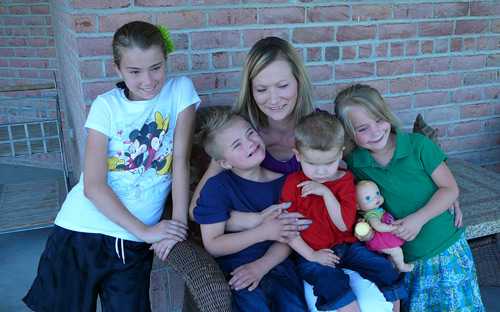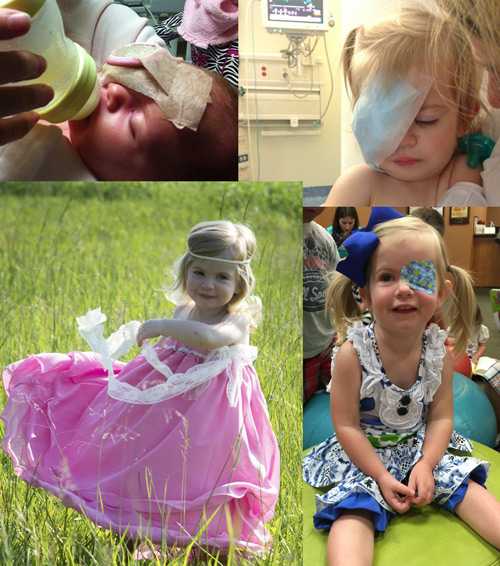Stories: Living with Eye Defects
Birth defects of the eye include conditions such as anophthalmia and congenital cataracts. To learn what it’s like to live with these conditions or how families are affected, read these real stories from people living with eye defects.

Bryton and Fenix’s Story—Written by their mom, Janalyn
Janalyn shares her family’s story of both of her sons: Fenix who was born with Down syndrome, and Bryton who was born with birth defects of his eyes. Although Janalyn’s family has faced many challenges, they have faced each challenge head on, not willing to give up or be knocked down. Read their inspiring story:
I am a proud mother of four beautiful children: two boys and two girls. Both of my sons were born with birth defects. Fenix, the older of the two boys, has Down syndrome.
Things were rough when we first found out. My husband and I had little to no experience with Down syndrome. He was hospitalized multiple times as a baby because of respiratory illnesses. He is a very energetic child who loves sports and music. He loves life. His future is very bright.
My youngest child, Bryton, was born with anophthalmia (missing eye) on his left side and micropthalmia (small eye) on his right side. Because of this, he is completely blind. Once again, our family was in a state of disbelief. Once the shock wore off and we were able to get Bryton the medical care and help he needed to succeed, we were able to come together as a family once again. Bryton gives the greatest hugs and is always happy. We still have some challenges. His speech is delayed and he is just learning to walk. His laugh could brighten anyone’s day. We face many challenges as a family, but we face each challenge head on, not willing to give up or be knocked down. All my children deserve the best that life can give and that is what I am here for—to ensure that their lives are grand.

Harper’s Story-Written by her mom, Amiee
Connecting families with local services can help children with birth defects receive the special care they need. These local services and care have been important for Harper, who was born with a congenital cataract, a birth defect affecting her right eye.
On Christmas Eve, while my husband and I were wrapping last minute presents in our brightly lit living room, our 10-day-old daughter was wide awake. As we worked and played with our newborn, we noticed a round “cloudy” appearance in the middle of her right eye. My husband and I are both nurses, so we knew right away that we had discovered a cataract.
Our pediatrician assessed Harper a few days later and referred her to a pediatric ophthalmologist, a special eye doctor who confirmed the diagnosis of a congenital cataract. Doctors removed Harper’s cataract when she was six weeks old. Because they removed the lens of her eye during the surgery, Harper started wearing a contact lens in her right eye when she was 8 weeks old. She also began patch therapy. This type of therapy involved putting an eye patch over her left eye in order to strengthen her right eye. Patching helps to train her brain to send signals to the right eye to improve her eyesight.
When Harper was 1 year old, she got an infection in her right eye and her condition worsened. We were concerned as Harper regressed developmentally as well as visually. During this difficult time, we were in contact with a nurse from the Kentucky Birth Surveillance Registry. She informed us that Harper’s cataract diagnosis would qualify her for services through Kentucky’s Early Intervention Program. Harper began receiving developmental intervention and vision services through Vision Impaired Preschool (VIPS). When Harper was about 19 months old, she was diagnosed with glaucoma, which complicates things and will require at least three more surgeries.
In all honesty, there are good days and bad days. The parent struggle is real –from learning how to put a contact lens in an infant’s eye to coping with a defiant toddler not wanting to wear her patch. We get ongoing questions from her brother who wonders why his sister was born with visual impairment and from strangers who question why Harper is wearing an eye patch. And then there is the burden of increased healthcare costs, the amount of time off work, and the travel expenses for pediatric specialty appointments.
Despite all that, our hope is that there will be continued research into congenital cataracts, which could lead to advancements in medical treatments. We also hope for increased support for programs that assist children with visual impairments along with appropriate trainings for early intervention providers and schools.
We would like to end this story by telling you about Harper. She is a spunky child. Her vision is an ongoing battle to achieve her best visual potential. With the diligent support from our family and friends, her medical team, early intervention, patch therapy, medications, God’s blessings, consistency & routines in the home, Harper has thrived to be a sweet, social, independent and inspiring little girl.
- Page last reviewed: May 16, 2017
- Page last updated: May 16, 2017
- Content source:



 ShareCompartir
ShareCompartir